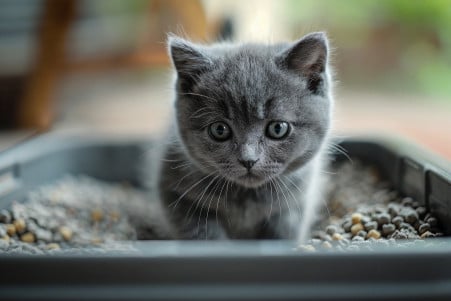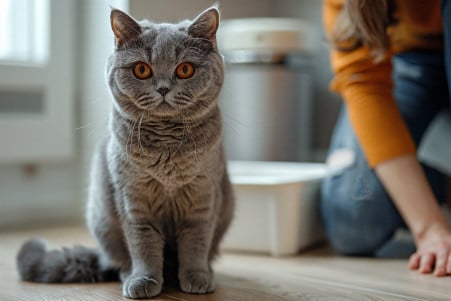How Long Can Cats Hold Their Pee? Understanding Feline Urinary Health
28 February 2024 • Updated 26 February 2024

Cats are often thought of as the epitome of cleanliness, but just how long can they go without using the litter box? While cats can hold their urine for 24–48 hours, it’s best to make sure they don’t go more than 12 hours without urinating to prevent potential health problems.
If you notice that your cat is holding their urine for longer than this, it’s time to take them to the vet, as prolonged periods of urine retention can cause serious issues.
This article will review veterinary scholarship, including physiological research on the feline urinary system and behavioral research on the environmental factors that can impact how often cats urinate. It will cover the average time cats can hold their urine as well as the factors that can influence this time.
The article will also discuss the potential health problems that can arise from infrequent urination. This information is important for cat owners who want to make sure their pets are healthy and happy.
How long can cats hold their pee?
How a Cat’s Bladder and Urethra Work
The bladder and urethra are part of the lower urinary tract in cats, and they are highly specialized parts of a cat’s anatomy that help them control when and where they urinate.
According to a study published on PubMed, the bladder is made up of a body, neck, and apex, and the urethra is divided into different segments in male cats. The muscular layer of the bladder and urethra, which includes the detrusor muscle for emptying and the internal and external urethral sphincters for continence, is responsible for keeping urine in the bladder.
The idea of ‘viscous accommodation’ is the bladder’s ability to stretch without a rise in internal pressure, which lets cats hold their urine for long periods without discomfort. This stretchiness, along with a complex nervous system that includes sympathetic and parasympathetic innervation, allows for precise control of when the bladder is emptied.
In addition, a cutting-edge study presented in ICS 2020 Abstract #254 used wireless sensors to monitor the pressure and volume of the bladder. As noted in an article in IEEE Transactions, the study by Steve J. A. Majerus shows that the bladder can adjust to different volumes, a process that can be affected by age and other health issues.
This research shows that the feline urinary system is highly adaptable and complex, and it demonstrates the physiological factors that dictate how often a cat urinates and how much urine it can hold.
How to Tell If Your Cat Is Peeing Enough
As Catster explains, a cat’s normal urination frequency is between two and four times a day, and this number can be influenced by the amount of water and food that your cat consumes.
If your cat is well-hydrated, they may urinate more often, so the number of times your cat pees can change based on how much they drink. The type of food that your cat eats can also change the frequency of urination because some foods can lead to more urine production.
There are also behavioral factors that can change how often a cat pees. For example, stress can lead to a cat not wanting to use the litter box, which can lead to changes in frequency.
Where the litter box is located can also change how often a cat uses it. The best place for a litter box is somewhere that is quiet, easy to get to, and clean.
As Pet Keen points out, the cleanliness of the litter box is especially important because cats can refuse to use a litter box that is dirty or in a location that they don’t like.
It’s important to know the signs of urinary retention so that you can make sure that your cat is healthy.
As Hepper notes, if your cat’s urination frequency changes and they are peeing less than twice a day, you should take them to the vet.
Other signs of urinary retention include straining to urinate, going to the litter box often without urinating, and showing signs of pain while urinating. If your cat is hunched over while they pee, this is another sign that they may be having trouble urinating. All of these signs can be a sign of urinary retention, and if your cat is experiencing this, it can be a medical emergency.
The Dangers of Chronic Urinary Retention in Cats
Cats that experience chronic urinary retention are at an increased risk of developing a number of health issues. For example, cats that urinate less frequently are more likely to develop urinary tract infections and bladder stones.
As PetMD explains, functional urinary retention can lead to infections, bladder or urethra ruptures, and even permanent damage to the bladder’s muscles. In addition, male cats are especially susceptible to urethral obstruction due to their narrower urethras, which makes them more likely to experience blockages.
Feline Lower Urinary Tract Disease (FLUTD) is a group of conditions that can cause cats to frequently attempt to urinate, urinate with blood, and experience painful urination, according to PetMD. Stress, which is a leading cause of FLUTD, can make these symptoms worse, highlighting the link between mental health and physical health.
However, the effects of chronic urinary retention can be even more severe, leading to irreversible damage to organs and a decline in kidney function.
Pet owners should take their cats to the vet if they notice any changes in their cats’ urination habits, especially if their cat is straining to urinate or if their urine stream is weak. Catching these symptoms early and discussing them with a vet can help prevent the development of urinary conditions, protecting cats’ long-term health.
Understanding the Intersection of Cat Behavior and Environment
Cats, much like people, are creatures of habit and routine, and changes in their environment can have a big impact on their urinary patterns. An article in PMC notes that environmental factors are important for cat welfare, and cats are especially sensitive to stress related to their environment and the location and cleanliness of their litter boxes.
A stress-free environment with easy access to clean bathroom areas can help ensure that cats are able to urinate regularly and avoid urinary retention.
Information from the College of Veterinary Medicine at Cornell University about house soiling in cats explains that cats with behavioral problems, including anxiety, are more likely to experience urinary retention, and environmental stress can make these problems worse. It’s important to make sure that cats have an environment that allows them to engage in natural behaviors like scratching and climbing.
The American Association of Feline Practitioners also recommends environmental enrichment, including hiding spaces and interactive toys, to help reduce stress and support healthy urination.
With careful attention to both behavioral and environmental concerns, cat owners can create an environment that supports their cat’s natural urinary patterns. Taking a proactive approach to this can help ensure that cats are healthy and happy and that any changes in urinary behavior are quickly and effectively addressed.
How to Keep Your Cat’s Urinary System Healthy
It’s important to keep an eye on your cat’s urination habits. Make sure you’re cleaning the litter box regularly and paying attention to how often and how much your cat is urinating. If you notice any changes in your cat’s urination habits, such as straining or urinating small amounts more frequently, which are signs of Feline Lower Urinary Tract Disease (FLUTD) according to the American Veterinary Medical Association, you should consult your vet.
It’s also important to make sure your cat has the right litter box. It should be big enough, easy to get to, and in a quiet location. According to PetMD, a cat’s environment can have a big impact on their urinary habits, so it’s important to make sure the litter box is clean and inviting.
Keeping your cat on a regular schedule when it comes to feeding and playing can also help ensure regular urination. Feeding your cat a diet with plenty of moisture, such as canned food, can also help keep their urinary tract healthy. According to PetMD, it’s important to make sure your cat is eating a diet that supports bladder health.
Regular vet visits can also help ensure that any urinary issues are caught early. If you notice any changes in your cat’s urination habits, make sure to get them checked out by a professional as soon as possible.
According to the Greensboro Vet at Carolina Veterinary Specialists, it can be important to treat bladder or urinary issues as soon as possible. By staying on top of things and being proactive, you can help make sure your cat’s urinary system stays healthy and in working order.
Recap: What You Need to Know About Cat Bladders and Urination
When it comes to keeping your cat healthy, knowing how long cats can hold their pee is more than just a fun fact—it’s an important part of your cat’s overall well-being. This article has delved into the ins and outs of the feline bladder and urination, from the bladder’s structure and function to the neural pathways that control urination.
While cats can go 24 to 48 hours without peeing, it’s best to aim for no longer than 12 hours to avoid potential health problems.
From the psychological to the physical, there are many things that can impact a cat’s urination habits, including diet, hydration, stress, and the state of their litter box. Failing to take these factors into account can lead to serious health problems like urinary tract infections, bladder stones, and even life-threatening blockages.
That’s why it’s important for cat owners to be vigilant and attentive. Regularly monitoring your cat’s urination, ensuring that they’re in a low-stress environment, and feeding them a diet that promotes urinary health are all important. And don’t hesitate to consult a vet if you notice anything unusual.
By balancing an understanding of a cat’s natural instincts with our role in their lives, we can help ensure that our feline friends are happy and healthy, not just when it comes to their urinary health, but in every way. Keep these tips in mind and you can look forward to a lifetime of health and happiness for your cat.


